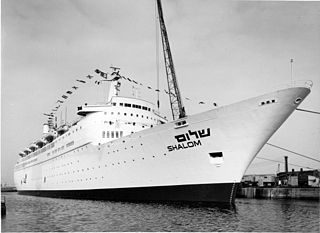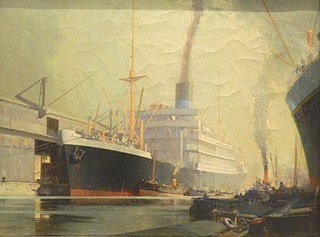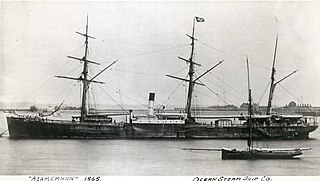
An ocean liner is a type of passenger ship primarily used for transportation across seas or oceans. Ocean liners may also carry cargo or mail, and may sometimes be used for other purposes. Only one ocean liner remains in service today.

The China Navigation Company. Pte. Ltd. is registered in Singapore — with parent entity The China Navigation Company Limited (CNCo), trading as Swire Shipping & Swire Bulk — is a merchant shipping company based in Singapore. It is part of the Swire group, formerly John Swire and Sons.

Alfred Holt and Company, trading as Blue Funnel Line, was a UK shipping company that was founded in 1866 and operated merchant ships for 122 years. It was one of the UK's larger shipowning and operating companies, and as such had a significant role in the country's overseas trade and in the First and Second World Wars.
SS Antenor was a UK steam turbine passenger and refrigerated cargo liner launched in 1924. She was the third of five ships to bear the name.
Antenor was an Athenian sculptor of the 6th century BC.
SS Antenor was the first of five ships to bear the name. She was built in 1872 by Hawthorn Leslie and Company at Hebburn-on-Tyne. She was built for Alfred Holt and Company, who owned various shipping lines including the Ocean Steam Ship Company (OSSC), Nederlandsche Stoomvaart Maatschappij Oceaan (NSMO), The China Mutual Steam Navigation Company (CMSNC) and Blue Funnel Line. SS Antenor had a gross registered tonnage (GRT) of 2,074, was 322 feet (98 m) long, had a beam of 33 feet 7 inches (10.24 m) and a service speed of 10 knots. She was powered by a single screw, two cylinder compound tandem steam engines; 214 NHP, 700 IHP. Her sister ships were SS Deucalion (1872), SS Glaucus (1871) and SS Patroclus (1872).
SS Antenor was the second of five ships to bear the name. She was built in 1896 by Workman, Clark and Company at Belfast, Northern Ireland. She was built for Alfred Holt and Company, who owned various shipping lines including the Nederlandsche Stoomvaart Maatschappij Oceaan (NSMO) and Blue Funnel Line. SS Antenor had a gross registered tonnage (GRT) of 5,570, was 422 feet long, had a beam of 49 feet 4 inches and a service speed of 10 knots. She was powered by a triple expansion steam engine, 4000 IHP. Her sister ships were SS Glaucus (1896), SS Patroclus (1896) and SS Prometheus (1896). She was the last of the class and cost £62,796, £5 cheaper than her sister ship SS Patroclus.
MS Antenor was a British cargo ship, and the fourth of five ships to bear the name. She was built in 1956-57 at the Vickers-Armstrongs Naval Yard, at High Walker, Newcastle upon Tyne, for Alfred Holt and Company, who owned various shipping lines including the Ocean Steam Ship Company (OSSC) and Blue Funnel Line.

SS Shalom was a combined ocean liner/cruise ship built in 1964 by Chantiers de l'Atlantique, St Nazaire, France, for ZIM Lines, Israel, for transatlantic service from Haifa to New York. In 1967, SS Shalom was sold to the German Atlantic Line, becoming their second SS Hanseatic. Subsequently she served as SS Doric for Home Lines, SS Royal Odyssey for Royal Cruise Line and SS Regent Sun for Regency Cruises. The ship was laid up in 1995 following the bankruptcy of Regency Cruises. Numerous attempts were made to bring her back to service, but none were successful. The ship sank outside Cape St. Francis, South Africa, on 26 July 2001, while en route to India to be scrapped.
SS Patroclus was a UK steam turbine passenger and refrigerated cargo liner launched in 1923. She was the third of five ships to bear the name.

SS Sarpedon was a UK steam turbine passenger and refrigerated cargo liner launched in 1923. She was the fourth of six ships to bear the name.

HMS Hector was a UK steam turbine passenger and refrigerated cargo liner launched in 1924. She was the fourth of six civilian ships to bear the name.

MS Golden Princess was a casino cruise ship owned by Eurasia International, operated on short casino cruises out of Hong Kong. She was built in 1967 by the Wärtsilä Hietalahti shipyard in Helsinki, Finland as Finlandia for the Finland Steamship Company. In 1975 she was sold to Finnlines, who converted her into the cruise ship Finnstar in 1978. In 1982 she entered service for Pearl Cruises as Pearl of Scandinavia. In 1988 she was renamed Ocean Pearl. In 1994 she entered service with Croisières Paquet as Pearl. Between 1995 and 1998 she sailed for Costa Cruises as Costa Playa. In 1998-1999 she sailed as Oriental Pearl for Mega Wave International, and in 1999-2000 as Joy Wave for Costa Cruises. In 2000 she was sold to Eurasia International and entered service under the name Golden Princess. In 2009 she was sold for scrap to China.
Ocean Group plc was a major British transport business. It was listed on the London Stock Exchange and was a constituent of the FTSE 250 Index.

SS Agamemnon was one of the first successful long-distance merchant steamships. She was built in 1865 to trade between Britain and China, and competed with tea clippers before and after the opening of the Suez Canal in 1869. She brought together three improvements in steamship design: higher boiler pressure, an efficient and compact compound steam engine, and a hull form with modest power requirements.

SS Cyclops was a British cargo steamship of Alfred Holt and Company. She was built in Glasgow in 1906, served in both the First and Second World Wars and survived two German submarine attacks in 1917. A German submarine sank her in January 1942 off the coast of Nova Scotia, killing 87 of the men aboard her. This was the first attack of the Kriegsmarine's Unternehmen Paukenschlag to destroy Allied merchant shipping in the Western Atlantic.

Lamport and Holt was a UK merchant shipping line. It was founded as a partnership in 1845, reconstituted as a limited company in 1911 and ceased trading in 1991.
SS Tyndareus was a British steamship that was built in 1914–15 as a cargo liner for the Blue Funnel Line of the Ocean Steamship Company. Completed during the First World War, she served as a troop ship and was nearly sunk by a German naval mine, but without loss of life. Between the wars she operated commercially in the Pacific Ocean, before returning to military service in the Second World War. Her final civil role was to carry Islamic pilgrims from Indonesia to Mecca, before being scrapped in 1960.

Killick Martin and Company Ltd is a privately owned global transport and logistics company with its head office in the United Kingdom. The company can trace its origins back to 1861 when it was founded by Captain James Killick and James Henry Martin. The company provides ocean freight, air freight, road freight, customs clearance, warehousing and supply chain management services. The company today has 5 offices in the United Kingdom and a global network of agencies. The ultimate parent company is Atlantic Pacific Group Ltd.










